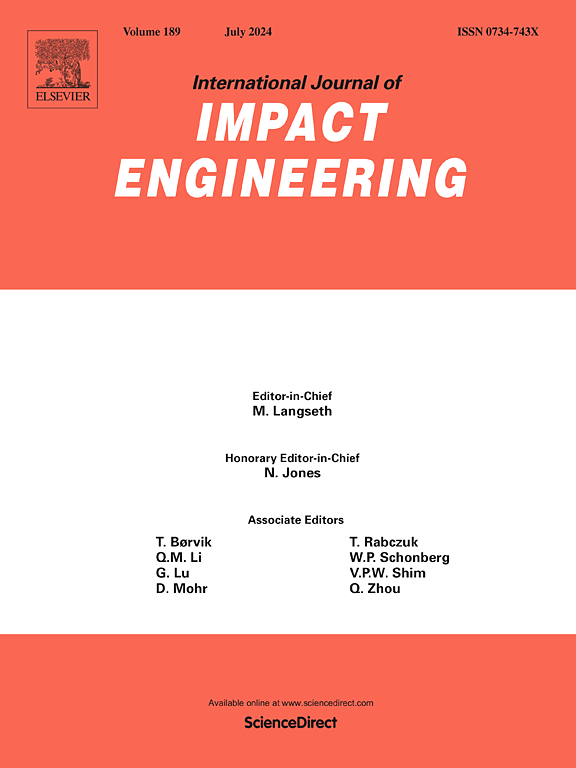Low-velocity impact performance and damage mechanisms of all-CFRP honeycomb sandwich shell
IF 5.1
2区 工程技术
Q1 ENGINEERING, MECHANICAL
International Journal of Impact Engineering
Pub Date : 2025-02-03
DOI:10.1016/j.ijimpeng.2025.105231
引用次数: 0
Abstract
This study investigates the damage behavior of all-CFRP (carbon fiber reinforced polymer) honeycomb sandwich shells subjected to low-velocity impacts, utilizing both experimental methods and simulation results based on the modified Hashin criterion. The results reveal that both the initial damage load and peak load significantly increase with facesheet thickness, while the increase due to impact energy is relatively modest. Moreover, impacts at the honeycomb center produce distinct cross-shaped damage, while impacts along the honeycomb cell walls result in more chaotic damage patterns. A comparison of axial and circumferential damage volumes indicates that the inherent circumferential curvature and complex boundary of honeycomb sandwich shells leads to greater damage in the circumferential direction. Additionally, foam-reinforced honeycomb shells are fabricated using a winding-based method combined with foam infusion, demonstrating how facesheet thickness and impact energy influence damage failure. The analysis of specific energy absorption efficiency shows that increasing facesheet thickness and adding foam significantly enhance energy absorption capabilities. Finally, the effects of impactor diameter and shape on the resulting damage are investigated, providing a comprehensive understanding of the factors that influence the damage response of composite honeycomb sandwich shells under low-velocity impacts.

全cfrp蜂窝夹层壳低速冲击性能及损伤机理
采用实验方法和基于修正Hashin准则的仿真结果,研究了全cfrp(碳纤维增强聚合物)蜂窝夹层壳在低速冲击下的损伤行为。结果表明:初始损伤载荷和峰值载荷均随面板厚度的增加而显著增加,而冲击能的增加相对较小;在蜂窝中心的撞击产生明显的十字形损伤,而沿着蜂窝细胞壁的撞击产生更多的混沌损伤。轴向和周向损伤体积的对比表明,蜂窝夹层壳固有的周向曲率和复杂的边界导致其周向损伤更大。此外,采用基于卷绕的方法结合泡沫注入制造泡沫增强蜂窝壳,展示了面板厚度和冲击能量如何影响损伤失效。比吸能效率分析表明,增加面板厚度和添加泡沫显著提高吸能能力。最后,研究了冲击器直径和形状对损伤的影响,全面了解了低速冲击下复合材料蜂窝夹层壳损伤响应的影响因素。
本文章由计算机程序翻译,如有差异,请以英文原文为准。
求助全文
约1分钟内获得全文
求助全文
来源期刊

International Journal of Impact Engineering
工程技术-工程:机械
CiteScore
8.70
自引率
13.70%
发文量
241
审稿时长
52 days
期刊介绍:
The International Journal of Impact Engineering, established in 1983 publishes original research findings related to the response of structures, components and materials subjected to impact, blast and high-rate loading. Areas relevant to the journal encompass the following general topics and those associated with them:
-Behaviour and failure of structures and materials under impact and blast loading
-Systems for protection and absorption of impact and blast loading
-Terminal ballistics
-Dynamic behaviour and failure of materials including plasticity and fracture
-Stress waves
-Structural crashworthiness
-High-rate mechanical and forming processes
-Impact, blast and high-rate loading/measurement techniques and their applications
 求助内容:
求助内容: 应助结果提醒方式:
应助结果提醒方式:


